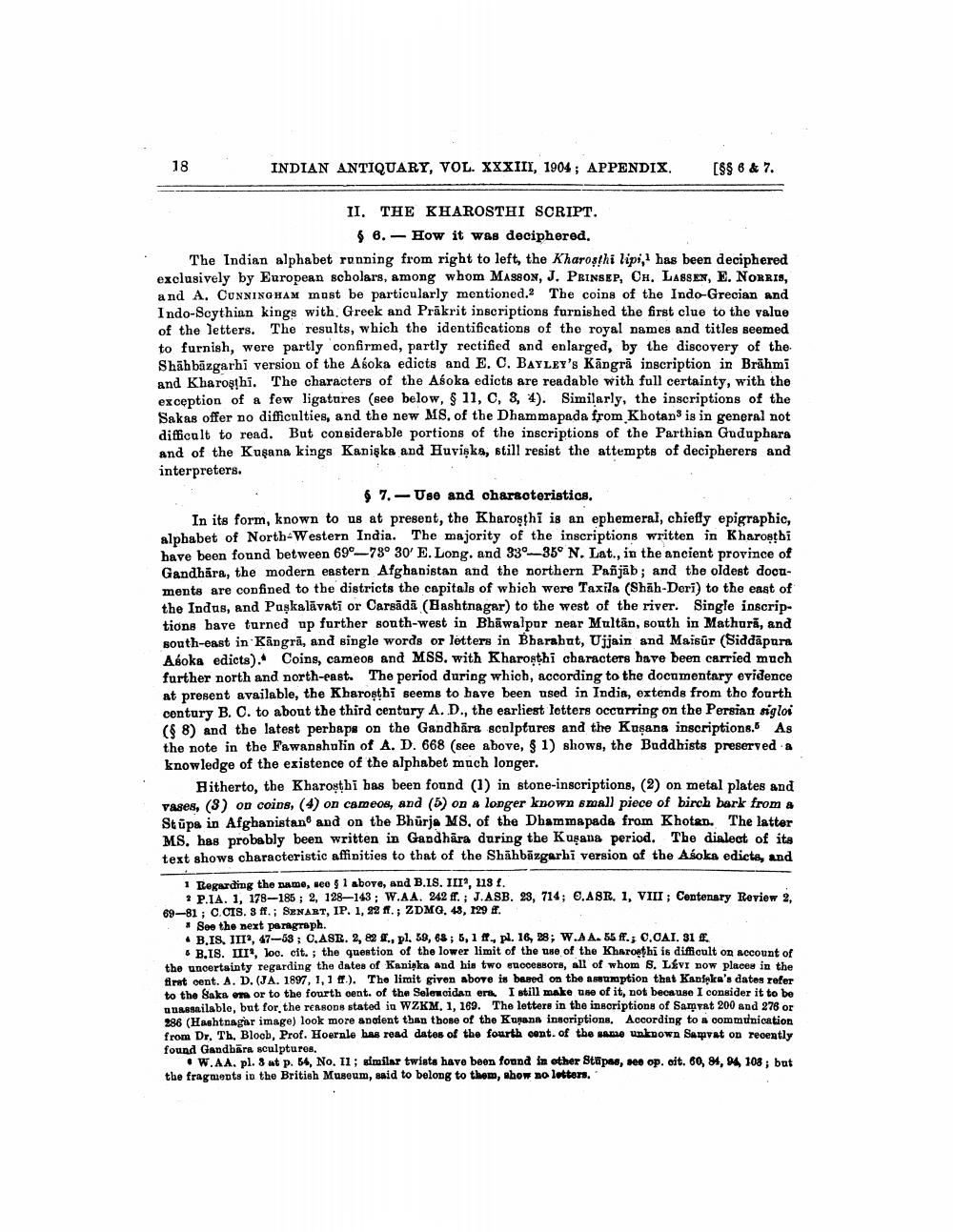________________
18
INDIAN ANTIQUARY, VOL. XXXIII, 1904; APPENDIX.
[$$ 6 & 7.
II. THE KHAROSTHI SCRIPT.
68. - How it was deciphered. The Indian alphabet ronning from right to left, the Kharosthi lipit has been deciphered exclusively by European scholars, among whom MASON, J. PRINSEP, CH. LASSEN, E. NORRIS, and A. CUNNINGHAM must be particularly mentioned. The coins of the Indo-Grecian and Indo-Scythian kinge with. Greek and Prākrit inscriptions furnished the first clue to the value of the letters. The results, which the identifications of the royal names and titles seemed to furnish, were partly confirmed, partly rectified and enlarged, by the discovery of the Shāh bāzgarhi version of the Asoka edicts and E. C. BAYLEY's Kangri inscription in Brühmi and Kharoahi. The characters of the Asoka edicts are readable with full certainty, with the exception of a few ligatures (see below, $ 11, C, 3, 4). Similarly, the inscriptions of the Sakas offer no difficulties, and the new MS, of the Dhammapada from Kbotan is in general not difficult to read. But considerable portions of the inscriptions of the Parthian Guduphara and of the Kuşana kings Kanişka and Huviška, still resist the attempts of decipherers and interpreters.
7.- Use and characteristics. In its form, known to us at present, the Kharoşthi is an ephemeral, chiefly epigraphic, alphabet of North-Western India. The majority of the inscriptions written in Kharosthi have been found between 690-78° 30' E. Long and 33o-35° N. Lat., in the ancient province of Gandhāra, the modern eastern Afghanistan and the northern Pañjāb; and the oldest documents are confined to the districts the capitals of which were Taxila (Shāh-Deri) to the east of the Indus, and Puşkalāvati or Carsādā (Hashtnagar) to the west of the river. Single inscriptions have turned up further south-west in Bhāwalpur near Multān, south in Mathură, and south-east in Kangră, and single words or letters in Bharabat, Ujjain and Maisūr (Siddāpara Aboka edicts). Coins, cameos and MSS. with Kharosthi characters have been carried much further north and north-east. The period during which, according to the documentary evidence at present available, the Kharosthi seems to have been used in India, extends from the fourth century B. C. to about the third century A.D., the earliest letters occurring on the Persian sigloi (6 8) and the latest perbaps on the Gandhāra sculptures and the Kuşana inscriptions. As the note in the Fawanghulin of A. D. 668 (see above, $ 1) shows, the Buddhists preserved a knowledge of the existence of the alphabet much longer.
Bitherto, the Kharosthi bas been found (1) in stone-inscriptions, (2) on metal plates and vases, (3) on coins, (4) on cameos, and (5) on a longer known small piece of birch bark from a Stüpa in Afghanistan and on the Bhurja MS, of the Dhammapada from Khotan. The latter MS, has probably been written in Gandhāra during the Kupana period. The dialect of its text shows characteristic affinities to that of the Shāhbāzgarhi version of the Asoka edicts, and
1 Regarding the name, leo $ 1 above, and B.IS. III, 119 f.
? P.IA. 1, 178-185 ; 2, 128-143 : W.AA. 242 f.; J.ASB. 23, 714; 6,ASR, 1, VIII; Centenary Review 2. 69-81 ; C.CIS. ff.; SENART, IP. 1, 92 11.; ZDMG. 43, 129 8.
* See the next paragraph. • B.IS, III, 47-58; C.ASR. 2, 2 d., pl. 59, 68; 5,1 f. pl. 16, 28; W.AA. 55 ff.; C.CAI. 31
* B.IS. III, loo. cit.; the question of the lower limit of the use of the Kharoythi is difficult on account of the cortainty regarding the dates of Kaninka and his two successors, all of whom B. LEVI now places in the first cent. A. D. (JA, 1897, 1, 1 ). The limit given above is based on the assumption that Kanlala's dates refer to the sake one or to the fourth oent. of the Seleucidan erth. I still make use of it, not because I consider it to be anasailablo, but for the reasons stated in WZKM, 1, 169. The lettere in the inscriptions of Samvat 200 and 276 or 286 (Hashtnagar image) look more ancient than those of the Kuana inscriptions. According to a communication from Dr. Th. Blocb, Prof. Hoernle has read dates of the fourth cent. of the same unknown Saprat on recently found Gandbära sculptures.
•W.AA. pl. 8 at p. 54, No. 11; similar twists have been found in other stūpas, see op. cit. 60, 84, 94 108 ; but the fragments in the British Museum, said to belong to them, show so letters.




